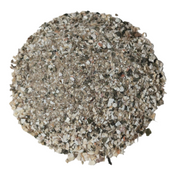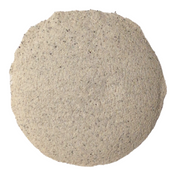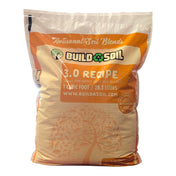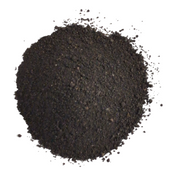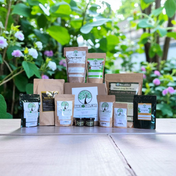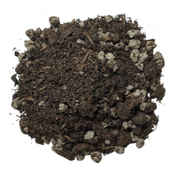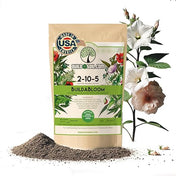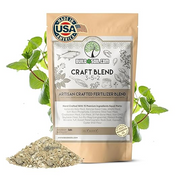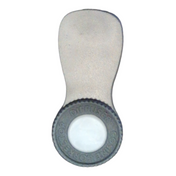Agricultural Gypsum Uses
Agricultural Gypsum (Calcium Sulfate - CaSO4) is one of those rare materials that performs in all three categories of soil treatment: an amendment, conditioner, and fertilizer.
Soil conditioners, such as gypsum, are seriously undervalued compared to fertilizer usage. Dr. Arthur Wallace (Ph.D. Soil Science and Plant Nutrition) and Dr. Garn Wallace (Ph.D. Bio-Chemistry) of Wallace Laboratories in El Segundo, CA, U.S.A., believe that if soil structure ain't right, then nothing is right.
Lets look at it from the plants point of view. The bottom-line question here is AVAILABILITY. How much calcium sulfate (nutrition) is available to the plant to meet its gypsum requirement when it needs it? The same is true with the soil. If it does not get gypsum when it needs it, the soil may compact, prevent water and air penetration, lose its leaching ability and become saturated with salt or other excessive elements harmful to plant growth and health. Then the plant suffers from bad soil conditions.
Poor soil structure is a major limiting factor in crop yield. The bottom line to the many benefits of gypsum is higher yield at a minimum cost.
Gypsum Improves Compacted Soil
Gypsum can help break up compacted soil. Soil compaction can be prevented by not plowing or driving machinery on soil when it is too wet. The compaction in many, but not all soils can be decreased with gypsum, especially when combined with deep tillage to break up the compaction. Combination with organic amendments also helps, especially in preventing return of the compactions. (1)
Gypsum Decreases Bulk Density of Soil
Gypsum-treated soil has a lower bulk density compared with untreated soil. Organics can even decrease it more when both are used. The softer soil is easier to till, and crops like it better. (1)
Gypsum Helps Prepare Soil for No-Till Management
A liberal application of gypsum is a good procedure for starting a piece of land into no-till soil management or pasture. Improved soil aggregation and permeability will persist for years and surface-applied fertilizers will more easily penetrate as a result of the gypsum. (1)
Gypsum Prevents Crusting of Soil and Aids Seed Emergence
Gypsum can decrease and prevent the crust formation on soil surfaces which result from rain drops or from sprinkler irrigation on unstable soil. Prevention of crust formation means more seed emergence, more rapid seed emergence, and easily a few days sooner to harvest and market. Seed emergence has been increased often by 50 to 100 percent. The prevention of crusting in dispersive soils is a flocculation reaction. (1)
Gypsum Decreases Loss of Fertilizer Nitrogen to the Air
Calcium from gypsum can help decrease volatilization loss of ammonium nitrogen from applications of ammonia, ammonium nitrate, UAN, urea, ammonium sulfate, or any of the ammonium phosphates. Calcium can decrease the effective pH by precipitating carbonates and also by forming a complex calcium salt with ammonium hydroxide which prevents ammonia loss to the atmosphere. Actually calcium improves the uptake of nitrogen by plant roots especially when the plants are young. (11)(12)(14)
Gypsum Helps Plants Absorb Plant Nutrients
Calcium, which is supplied in gypsum, is essential to the biochemical mechanisms by which most plant nutrients are absorbed by roots. Without adequate calcium, uptake mechanisms would fail. (7)
Gypsum Stops Water Runoff and Erosion
Gypsum improves water infiltration rates into soils and also the hydraulic conductivity of the soil. It is protection against excess water runoff from especially large storms that are accompanied with erosion. (1)
Gypsum Decreases Dust Erosion
Use of gypsum can decrease wind and water erosion of soil. Severe dust problems can be decreased, especially when combined with use of water-soluble polymers. Less pesticide and nutrient residues will escape from the surface of land to reach lakes and rivers when appropriate amendments are used to stabilize soil. Gypsum has several environmental values.(1)
Gypsum Improves Soil Structure
Gypsum provides calcium which is needed to flocculate clays in soil. It is the process in which many individual small clay particles are bound together to give much fewer but larger particles. Such flocculation is needed to give favorable soil structure for root growth and air and water movement. (1)
Gypsum Improves Fruit Quality and Prevents Some Plant Diseases
Calcium is nearly always only marginally sufficient and often deficient in developing fruits. Good fruit quality requires an adequate amount of calcium. Calcium moves very slowly, if at all, from one plant part to another and fruits at the end of the transport system get too little. Calcium must be constantly available to the roots. In very high pH soils, calcium is not available enough; therefore, gypsum helps. Gypsum is used for peanuts, which develop below ground to keep them disease free. Gypsum helps prevent blossom-end root of watermelon and tomatoes and bitter pit in apples. Gypsum is preferred over lime for potatoes
grown in acid soils so that scab may be controlled. Root rot of avocado trees caused by Phytophthora is partially controlled by gypsum. (9)(17)
Gypsum Improves Swelling Clays
Gypsum can decrease the swelling and cracking associated with high levels of exchangeable sodium on the montmorillonite-type clays. As sodium is replaced by calcium on these clays, they swell less and therefore do not easily clog the pore spaces through which air, water and roots move. (2)
Gypsum Makes Slightly Wet Soils Easier To Till
Soils that have been treated with gypsum have a wider range of soil moisture levels where it is safe to till without danger of compaction or deflocculation. This is accompanied with greater ease of tillage and more effective seedbed preparation and weed control. Less energy is needed for the tillage. (1)
Gypsum Prevents Water logging of Soil
Gypsum improves the ability of soil to drain and not become waterlogged due to a combination of high sodium, swelling clay, and excess water. Improvements of infiltration rate and hydraulic conductivity with use of gypsum add to the ability of soils to have adequate drainage. (2)
Gypsum Helps Make Stable Soil Organic Matter
Gypsum is a source of calcium which is a major mechanism that binds soil organic matter to clay in soil which gives stability to soil aggregates. The value of organic matter applied to soil is increased when it is applied with gypsum. (4)
Gypsum Increases Value of Organics
Gypsum adds to the value of organic amendments. Blends of gypsum and organics increase the value of the other as soil amendments, especially for improvement of soil structure. High levels of soil organic matter are always associated with liberal amounts of calcium which is part of gypsum. Calcium decreases burn out of soil organic matter when soils are cultivated by bridging the organic matter to clay. (4)
Gypsum Corrects Subsoil Acidity
Gypsum can improve some acid soils even beyond what lime can do for them. Surface crusting can be prevented. The effects of toxic soluble aluminum can be decreased, including in the subsoil where lime will not penetrate. It is then possible to have deeper rooting with resulting benefits to the crops. The mechanism is more than replacement of acidic hydrogen ions which can be leached from the soil to give higher pH. Hydrogen ions do not migrate rapidly in soils containing clay. It is suggested that the sulfate from gypsum forms a complex (AIS04+) with aluminum which renders the aluminum non-toxic. Also suggested is that the sulfate ions react with iron hydroxides to release hydroxyl ions which give a lime effect to increase soil pH. Gypsum is now being widely used on acid soils. (1)(6)
Gypsum has 17% Sulfate
Gypsum has 17% sulfate, which is the most absorbable form of sulfur for plants.
Gypsum Helps Reclaim Sodic Soils
Gypsum is used in the reclamation of sodic soils. Where the exchangeable sodium percentage (ESP) of sodic soils is too high, it must be decreased for soil improvement and better crop growth. The most economical way is to add gypsum which supplies calcium. The calcium replaces the sodium held on the clay-binding sites. The sodium can then be leached from the soil as sodium sulfate to an appropriate sink. The sulfate is the residue from the gypsum. Without gypsum, the soil would not be leachable. Sometimes an ESP of three is too high, but sometimes up to ten or more can be tolerated. (2)
Gypsum Decreased pH of Sodic Soils
Gypsum immediately decreases the pH of sodic soils or near sodic soils from values often over 9 but usually over 8 to values of from 7.5 to 7.8. These values are in the range of acceptability for growth of most crop plants. Probably more than one mechanism is involved. Ca++ reacts with bicarbonate to precipitate CaCO3 and release protons which decrease the pH. Also, the level of exchangeable sodium is decreased which lessens the hydrolysis of clay to form hydroxides. These reactions can decrease the incidence of lime and bicarbonate induced iron deficiency. (3)
Gypsum Makes Water-Soluble Polymer Soil Conditioners More Effective
Gypsum complements or even magnifies the beneficial effects of water-soluble polymers used as amendments to improve soil structure. Like for organic matter, calcium, which comes from gypsum, is the mechanism for binding of the water-soluble polymers to the clay in soils. (15)
Gypsum Makes Magnesium Non-Toxic
In soils having unfavorable calcium: magnesium ratios, such as serpentine soils, gypsum can create a more favorable ratio.(5)
Gypsum Improves Water-Use Efficiency
Gypsum increases water-use efficiency of crops. In areas and times of drought, this is extremely important. Improved water infiltration rates, improved hydraulic conductivity of soil, better water storage in the soil all lead to deeper rooting and better water-use efficiency. From 25 to I 00 per cent more water is available in gypsum-treated soils. (1)
Gypsum Makes It Possible to use Low Quality Irrigation Water
The effective sodium absorption ratio (SAR) of irrigation water should be less than 6 for some crops and less than 9 for others. When it exceeds these limits, gypsum should be applied to the soil or to the water. Use of reclaimed municipal waste water is important for conservation of natural resources. Reclaimed water can be satisfactorily used if amendments, such as gypsum and water-soluble polymers, are also used. Care must be taken, however, to avoid sodium build up in the lower horizons of soil because of excessive leaching when swelling clays are present. (16)
Gypsum Decreases Heavy-Metal Toxicity
Calcium also acts as a regulator of the balance of particularly the micro-nutrients, such as iron, zinc, manganese and copper, in plants. It also regulates non-essential trace elements. Calcium prevents excess uptake of many of them; and once they are in the plant, calcium keeps them from having adverse effects when their levels get high. Calcium in liberal quantities helps to maintain a healthy balance of nutrients and non nutrients within plants. (8)
Gypsum Decreases the Toxic Effect of NaCl Salinity
Calcium from gypsum has a physiological role in inhibiting the uptake of Na by plants. For species of plants not tolerant to NA, Ca protects from toxicity of NA but not Cl. (10)
Gypsum Keeps Clay Off Tuber and Root Crops
Gypsum can help keep clay particles from adhering to roots, bulbs and tubers of crops like potato, carrots, garlic and beets. In combination with water-soluble polymers, it is even more beneficial. (15)
Gypsum Helps Earthworms to Flourish
A continuous supply of calcium with organics is essential to earthworms that improve soil aeration, improve soil aggregation and mix the soil. Earthworms can do the plowing for no-till agriculture. (13)
References
|
1. Shainberg, I., M.E. Sumner, W.P. Miller, M.P.W. Farina, M.A. Pavan, and M.V Fey, 1989. Use of gypsum on soils: A review, pp. 1-1 I 1. IN: B.A. Stewart (ed.), Advances in Soil Science, Vol. 9, Springer-Verlag New York. 6. Smyth, T.J. and M.S. Cravo, 1992. Aluminum and calcium constraints to continuous crop production in a Braziliam Amazon Oxisol. Agron. J. 84:843-850. 9. Scott, W.D., B.D. McCraw, J.E. Motes, and M.W. Smith. |
10. Akhovan-Kharazian, M., W.F. Campbell, J.J. Jurinak, and L.M. Dudley, 199 1. Effects of calcium sulfate, calcium chloride, and sodium chloride on leaf nitrogen, nodule weight, and acetylene reduction activity in Phaseolus vulgaris L. Arid Soil Res. Rehabil. 5:97-103. 17. Shear, C.B. 1979. International symposium on calcium nutrition of economic crops. Comm. Soil Sci. Plant Anal. 10:11-501
|

